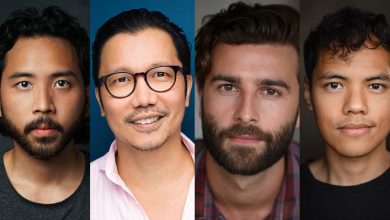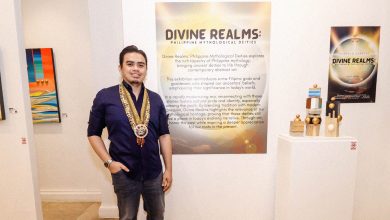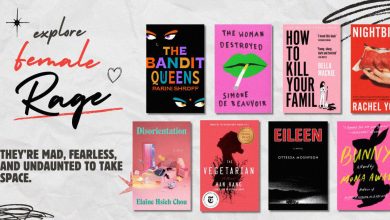PASADENA, USA — Fulcrum Arts launched their transmedia publishing platform, Sequencing, with sound artist and opera singer Micaela Tobin’s “The Carrying Voice” this February. An interactive collection of the voices of Filipinos living in the diaspora, the piece invites users to record a message to their ancestors, mapping the relationship between contributors’ current locations to a given point in the Philippines to create a metaphorical sonic bridge back to their ancestral land. The publication, launched in February, is accessible at fulcrumarts.org/sequencing/the-carrying-voice.
To culminate the work, Tobin collects vocal contributions from the public and organizes them into a new musical composition. She will perform the finished work live on Sequencing later in 2022. Through March 11, visitors are invited—per the artist’s prompt—to directly record their voices into “The Carrying Voice” map. The recordings will be incorporated into her forthcoming multimedia performance and ultimately archived on Tobin’s Sequencing publication.
With this open call, Tobin bridges a metaphorical and physical gap across oceans and shores and connects communities dispersed throughout the world to their ancestors. In creating this project, Tobin shared, “I try to make a bridge with my mind, with my voice, with my music. I sit on the edge of my culture—one foot in, one foot out. Whiteness can erase you before you even know who you are. To always be on the edge, looking in…I must make my own map home.”
About Micaela Tobin:
Micaela Tobin is a soprano, sound artist, and teacher based in Los Angeles, CA who specializes in experimental voice and contemporary opera. As a sound artist with a background in opera, Micaela integrates voice and electronics within the genres of noise and drone music. Her work incorporates ritualized gesture and amplified object-symbolism and explores her diasporic identity as a first-generation Filipina-American. Micaela’s vocal practice is based on building connections between the physical voice as a means of empowering one’s ‘inner’ voice and challenging colonial stories and systems.
Composing primarily under the moniker White Boy Scream, Micaela dissects her operatic and extended vocal techniques through the use of electronics, oscillating between extreme textures of noise, drone, and operatic sound walls. Her most recent full-length album, BAKUNAWA (Deathbomb Arc) includes elements of sonic ritual, ancient myth, and ancestral memory. In May 2021, Micaela premiered the cinematic adaptation of the album through REDCAT, titled BAKUNAWA: Opera of the Seven Moons.
As an opera composer, Micaela premiered and earned a five-star review for her first original experimental opera Unseal Unseam at Edinburgh Festival Fringe in summer 2016. Her most recent opera, Belarion: A Space Opera, premiered at the American Legion Center in Pasadena, CA in 2019. Micaela is currently working on the sequel to her recent operatic film, APOLAKI: Opera of the Scorched Earth which is set to premiere in May 2023 through the MAP Fund. As a performer, Micaela played the principal role of Coyote in the critically acclaimed opera, SWEET LAND (dir. Yuval Sharon & Canuppa Luger; Comp. Raven Chacon & Du Yun). She also performed with The Industry in their groundbreaking opera Hopscotch, a mobile opera for 24 cars (dir. Yuval Sharon). She has toured with hip-hop experimentalists clipping. on their 2017 tour with The Flaming Lips. Micaela also appeared as a principal vocalist in the premiere of Ron Athey and Sean Griffith’s automatic opera, Gifts the Spirit, and as a soprano soloist alongside Annette Bening in Medea at UCLALive.
Micaela is currently a voice teacher on faculty at the California Institute for the Arts and teaches through her private studio, HOWL SPACE, in Los Angeles, CA.
About Sequencing
As an online platform, Sequencing provides a space for critical cultural conversations of our time and aims to create improved visibility and greater opportunities for BIPOC, queer, and female-identified people who explore cross-disciplinarity within art, science, social change, and technology—genres historically deficient in equitable representation. Welcoming media of all types, including emerging formats and hybrid modes of expression, the platform redefines what it means to be a “publication” and stands at the forefront of curatorial discovery.
As a signature program of Fulcrum Arts, Sequencing supports artist projects across the spheres of human creative achievement and reflects the diverse cultural groups that comprise the Pacific Rim. Artist expressions with a geographic focus favor a multicultural dialogue, decentralizing Eurocentric historical narratives in favor of more inclusive perspectives. With recent grant funding from the Weingart Foundation secured by its parent organization, Sequencing will be able to support diverse multidisciplinary artists by providing an especially empowering platform for their most adventurous projects. Fulcrum Arts will announce artist-driven projects as they are confirmed.
The format of Sequencing takes the shape of curated artist projects which radiate from written discourse and embrace expansive storytelling modes, from video and music to found sound and other documentary new media. In this project space, contemporary art practices interface with interdisciplinarity and engage with local communities, traversing a broad spectrum of topics relevant to our current moment. Publications, artworks, and projects are housed within the new website: fulcrumarts.org/sequencing
The Sequencing launch is celebrated with a new website which reinforces a robust curatorial vision. A fresh aesthetic and new features encourage visitor participation and deepened consideration. The custom taxonomy list on the right-hand column on the top of pages contains specific thematic curatorial keywords – first for Sequencing projects at-large on the landing page, and sequentially on each publication page. This feature provides a navigational function, like an interactive word cloud assisting readers as they explore the transmedia landscape of the platform. Thematic tags also help users categorize content at-a-glance and illuminate how multiple critical conversations on the convergence of art, science, and social change exist in one space. Users may embark on their own conceptual adventure and sift through myriad artist expressions and practices led by their own curiosity. Randomized issue numbers reflect the fact that the platform is a rhizomatic publication. What may read like codes or secure passwords are issue numbers generated by a scrambler that reorders the source text “Sequencing 0123456789.”
Rather than a standard sequence of numbers, this system apprehends multiplicities that exist across media. It also embraces the organic nature by which individual and collective ideation coalesces from complex artistic practices through time, space, and geography.
From October 2020 to December 2021, the publications curated by Geneva Skeen existed in the platform’s beta format. Featured artists, listed in order of appearance, include Sarah Rosalena Balbuena-Brady, Phillip Birch, Felipe Meres, Colleen Hargaden, Suzanne Kite, Celia Hollander, Nina Sarnelle, the artist collective MSHR (Birch Cooper and Brenna Murphy), Ryan Kuo, and Na Mira. These artists were chosen for their alignment with the Fulcrum Arts mission to champion creative and critical thinkers at the intersection of art and science to provoke positive social change and contribute to a more vibrant and inclusive community.










